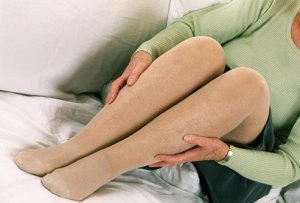
by Carolyn Thomas ♥ @HeartSisters
September is Peripheral Artery Disease Awareness Month, as I’m sure you have already noted on your calendar. But in case you haven’t yet made celebratory plans for the occasion, you should know that people with PAD are at greater risk for heart attack, stroke, or if not appropriately treated in time, even amputation of limbs.
Awareness, however, among both the general public and family physicians about diagnosis, treatment, and prevention of this cardiovascular disease is extremely low. It’s therefore a good thing that September is finally here so we can address this.
Just like all cardiovascular disease, PAD appears to be under-recognized in women. Among family physicians surveyed in 2002, for example, nearly all guessed that men over the age of 65 are most susceptible to PAD.
Most doctors excluded women as likely to have PAD at all. But women are equally at risk for developing this disease, and in fact may be more likely than men to have PAD without experiencing any symptoms; 50-90% of women are asymptomatic or have unrecognized symptoms of the disease, which could put them at greater risk of developing serious disease long before PAD is accurately diagnosed and appropriately treated.
Peripheral artery disease is relatively simple to diagnose. Get yourself tested if these factors are true for you:
- over age 50
- a family history of vascular disease, such as PAD, aneurysm, heart attack or stroke
- high cholesterol and/or high lipid blood test
- diabetes
- ex-smoker, or smoking now
- an inactive lifestyle
- a personal history of high blood pressure, heart disease, or other vascular disease
Peripheral Artery Disease symptoms include:
- cramping or tiredness in the leg or hip muscle when walking or exercising, relieved by resting (known as intermittent claudication, much more common in men than in women)
- pain in the legs or feet that awakens you at night, sometimes temporarily relieved by hanging your legs over the edge of your bed or walking around your room
- numbness, weakness, or tingling in the lower leg and foot
- coldness in lower leg or foot, especially when compared with the other leg
- hair loss on your feet and legs
- skin discolouration
- changes in toenails
- sores on leg, foot or toes, or other symptoms of skin breakdown that don’t heal
Identifying PAD before you develop any symptoms can be lifesaving for women, since it allows the easy diagnosis of a systemic disease that can be treated, the earlier the better. This treatment may include further investigation, treating significant areas of blockage that are found, lifestyle modification, and medication to slow the natural advancement of the disease.
 According to the Interventional Society of Radiology, the best and simplest diagnostic test to screen for possible PAD is a comparative blood pressure reading in the arm and ankle. It’s a direct measure of plaque buildup (atherosclerosis) in your leg arteries, and most importantly, it’s also an indirect gauge of plaque accumulations throughout your entire cardiovascular system.
According to the Interventional Society of Radiology, the best and simplest diagnostic test to screen for possible PAD is a comparative blood pressure reading in the arm and ankle. It’s a direct measure of plaque buildup (atherosclerosis) in your leg arteries, and most importantly, it’s also an indirect gauge of plaque accumulations throughout your entire cardiovascular system.
Because atherosclerosis is a systemic disease, women developing plaque in their legs are likely to also have plaque building up in:
- the carotid arteries, which can lead to stroke
- the coronary arteries, which can lead to heart attack
Find out more about peripheral artery disease in general.
.
Note: Information on this site is not intended as a substitute for medical advice. Consult your physician to discuss your own health.

PAD is a misunderstood condition….. Thx for helping us all to understand more. Very good job here on your site.
LikeLike
This is great stuff, very useful info. I had a number of problematic symptoms for a long time that I figured were just due to muscle soreness before I was finally diagnosed with PAD. Most women I know have no idea of this condition, so they have no idea of what to look out for. Thank you for including this info here – I am forwarding it to my friends and family, a lot of great stuff all in one article.
LikeLike